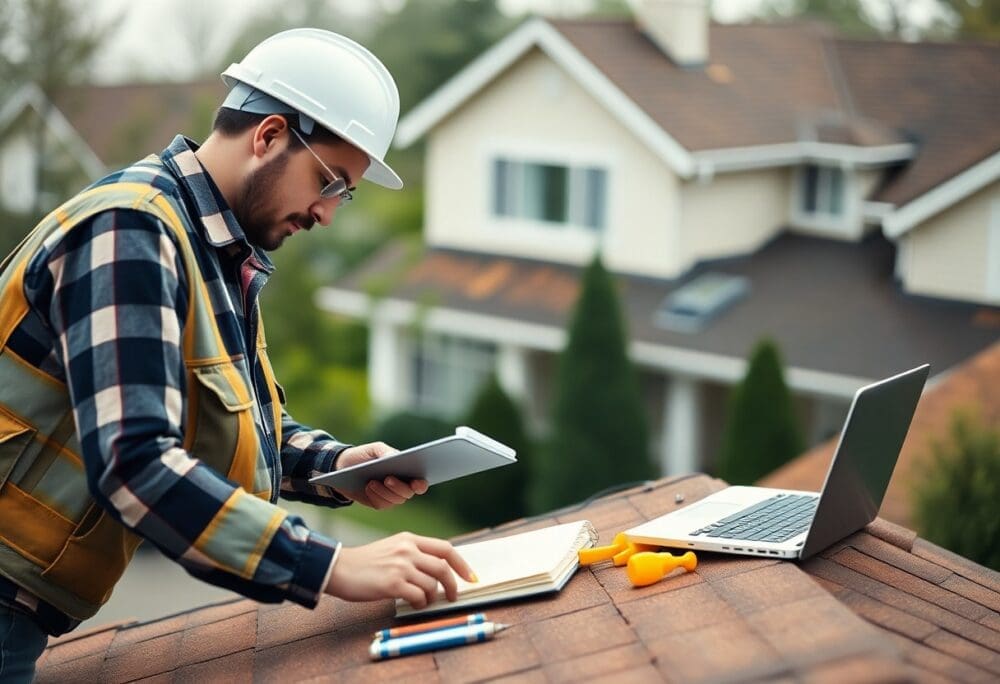It’s vital to understand how roof inspections impact your home insurance claims. When filing a claim for roof damage, your insurance provider often requires a thorough inspection to assess the extent of the damage and its cause. This process can significantly influence the outcome of your claim and the compensation you receive. By ensuring your roof is regularly inspected, you not only safeguard your home but also enhance your chances of a smoother claims process should the need arise.
Key Takeaways:
- Regular roof inspections can identify potential issues early, which can support your home insurance claims by providing documented evidence of the roof’s condition.
- Insurance companies often require proof of regular maintenance, including roof inspections, to validate claims related to roof damage or leaks.
- Having a recent roof inspection report can expedite the claims process and may enhance your chances of a favorable outcome when filing a claim.
Understanding Roof Inspections
While many homeowners view roof inspections as an optional task, they play a significant role in maintaining your home’s integrity and value. Regular inspections can identify issues before they escalate into costly repairs, ensuring that your roof remains in optimal condition. These inspections not only help protect your property but also provide important documentation for insurance purposes, facilitating smoother home insurance claims when needed.
Importance of Regular Roof Inspections
Behind every strong roof is ongoing maintenance, and regular inspections are a key element in preserving its lifespan. By proactively checking for damages, you can prevent minor problems from developing into larger, more expensive repairs. A well-documented inspection history also strengthens your position in any future insurance claims.
Types of Roof Inspections
With various types of roof inspections available, it is vital for you to understand which one suits your needs best. Each type serves a specific purpose, whether it’s for routine maintenance, after a major storm, or prior to the purchase or sale of your home. They help evaluate the condition of your roof, ensuring it meets safety and performance standards. Types of inspections include:
- Visual Inspections
- Infrared Inspections
- Drone Inspections
- Maintenance Inspections
- Post-Storm Inspections
| Type of Inspection | Description |
|---|---|
| Visual Inspections | Basic evaluation looking for obvious signs of damage. |
| Infrared Inspections | Detection of leaks and heat loss using infrared technology. |
| Drone Inspections | Cinematic aerial views for hard-to-reach areas. |
| Maintenance Inspections | Routine checks to ensure ongoing roof integrity. |
| Post-Storm Inspections | Assessing damage after severe weather events. |
Another way to understand roof inspections is by recognizing that each type can be tailored to your specific situation. For example, after severe weather, a post-storm inspection can save you from further damage by identifying urgent repairs. You might consider a comprehensive maintenance inspection to prolong the life of your roof and enhance its functionality. Each inspection type can serve different needs that align with the upkeep of your property.
- Comprehensive assessment to identify vulnerabilities.
- Serves as an important documentation for insurance claims.
- Facilitates informed decision-making regarding repairs.
- Can reveal underlying issues not visible during a casual observation.
- Perceiving a well-maintained roof contributes significantly to your home’s value.
| Type of Inspection | Benefits |
|---|---|
| Visual Inspections | Quick assessment for obvious damages. |
| Infrared Inspections | Precision in detecting hidden leaks. |
| Drone Inspections | Access to difficult areas without risking safety. |
| Maintenance Inspections | Ensure early identification of wear and tear. |
| Post-Storm Inspections | Immediate evaluation to address urgent concerns. |
Impact of Roof Condition on Home Insurance
Clearly, the condition of your roof plays a significant role in determining your home insurance coverage and premiums. A well-maintained roof can minimize risks of damage, potentially lowering your insurance costs, while an aging or damaged roof may lead to higher premiums or even difficulty obtaining coverage. Insurance companies often assess the state of your roof when processing claims, as signs of neglect can affect your eligibility for benefits. Regular inspections and maintenance of your roof can ensure continued coverage and peace of mind.
How Roof Damage Affects Insurance Claims
After experiencing roof damage, the way it affects your insurance claims primarily depends on the insurance policy you hold and the specifics of the damage. If your roof exhibits signs of neglect or failed maintenance, your claim may be denied, as insurers typically expect homeowners to proactively care for their roofs. It’s important to understand the circumstances that insurance companies consider before you file a claim, ensuring that you are prepared and informed.
Common Roof Issues Covered by Insurance
Covered roof issues often include storm damage, fire damage, vandalism, and certain types of wear and tear, depending on your policy. Each insurance provider has specific coverage stipulations, so it’s important to familiarize yourself with the terms of your policy.
With a clear understanding of common roof issues covered by insurance, you can better prepare for potential claims. Typically, damage resulting from severe weather events, such as hail or wind, is covered, as well as incidents involving falling trees. However, be sure to verify the specific conditions of your insurance policy, as the extent of coverage may vary. Regular inspections can help identify these issues before they escalate, making it easier for you to navigate the claims process should damage occur.
The Roof Inspection Process
Your roof is a significant component of your home, and understanding the roof inspection process ensures you are well-prepared for any insurance claims. A thorough inspection can identify potential issues before they escalate, helping you maintain your home’s integrity and your peace of mind. During the inspection, a professional will evaluate the condition of your roof, checking for any signs of wear and tear, leakage, or storm damage that may impact your insurance claim.
Steps of a Professional Roof Inspection
Inspection typically begins with a visual assessment from the ground, followed by a closer examination using ladders or drones. Inspectors look for missing shingles, cracks, corrosion, or any abnormalities in the roofing materials. Once the exterior is evaluated, the inspector checks the attic and interior for signs of water damage or insulation issues, providing a comprehensive overview of your roof’s health.
Criteria for Evaluating Roof Damage
Evaluating roof damage requires a keen eye for detail as several factors must be considered, including the age of the roof, the material used, and the extent of visible damage. Inspectors will assess not just the surface, but also underlying issues that may not be immediately visible, such as water leaks or structural weaknesses that could affect your home’s insurance coverage.
Plus, understanding the criteria helps you grasp the severity of the damage. Factors like the size and location of damage, the potential for further deterioration, and the overall lifespan of the roof are critical in determining whether repairs or a total replacement is necessary. Keeping this in mind can guide your discussions with insurance adjusters, ensuring that you receive a fair evaluation during your claim process.
Documenting Roof Inspections for Insurance Claims
After completing a roof inspection, you must document the findings accurately to facilitate your insurance claims process. Detailed records serve as proof of any damage and can significantly impact the outcome of your claim, ensuring your insurance company has the evidence needed to assess your situation fairly.
Essential Records and Reports
One of the key components in supporting your insurance claim is having comprehensive records and reports. Make sure to retain documents such as inspection reports, photographs of the roof’s condition, and any related correspondence with roofing professionals. These records will be instrumental in substantiating your claim and illustrating the extent of any damage.
Tips for Effective Documentation
Documenting your roof inspection effectively can enhance your insurance claim submissions. Follow these tips to ensure thorough documentation:
- Take clear, high-resolution photographs from various angles.
- Include close-ups of specific damage areas and any pertinent features.
- Organize your documents chronologically for easy reference.
Any confusion can delay the claims process, so clarity is crucial.
Considering the nuances of documentation, it is vital that you remain diligent in capturing every detail of the roof inspection. Take time to create comprehensive notes that include observations related to the roof’s age, materials, and any previous repairs. By maintaining thorough documentation, you can reinforce your claim effectively, ensuring nothing is overlooked.
- Clearly label your photos and documents for easy navigation.
- Document any conversations with your inspector regarding their findings.
- Store your documents securely and back them up digitally.
Any oversight in documentation can jeopardize your claim.
Choosing the Right Roofing Contractor
Keep in mind that selecting a qualified roofing contractor is vital to the success of your roof inspection and subsequent home insurance claims. A skilled contractor will understand the nuances of roofing materials, local building codes, and insurance requirements, ensuring that your home is properly assessed and repaired. Take the time to research and choose an experienced professional who can advocate for your needs during the insurance claim process. Your home’s roof is an investment, and partnering with the right contractor can make all the difference in your claim’s outcome.
Qualities to Look For
Qualities to consider in a roofing contractor include credibility, license and insurance, experience, and a solid reputation. You should seek contractors with positive customer reviews, reliable references, and a commitment to quality workmanship. Additionally, a good contractor will provide detailed, written estimates and communicate clearly throughout the process, helping to ensure that your roof inspection and repairs go smoothly while also aiding in any insurance claims.
Questions to Ask Before Hiring
Qualities such as transparency, reliability, and a thorough understanding of roofing systems are necessary traits in a roofing contractor. To evaluate these attributes, you should ask specific questions that reveal their competence and professionalism. Inquire about their experience with similar projects, their warranty policies, and how they handle insurance claims. These discussions will help you gauge their expertise and will also provide you with valuable insights into how they will manage your roof inspection and repair process.
Before hiring a roofing contractor, consider asking questions that dive deeper into their processes and expertise. For instance, ask how long they have been in business, whether they have experience working with your specific type of roofing, and if they can provide references from past clients. You may also want to know how they approach timelines and project management, as well as what steps they take to ensure clean-up and customer satisfaction. Gathering this information will empower you to make a more informed decision when selecting the right contractor for your roofing needs.
The Role of Roof Inspections in Preventing Claims Denials
Despite the importance of roof inspections, many homeowners overlook them, leading to potential claim denials. Inspections enable you to identify and address existing issues before filing a claim, ensuring your roof meets the necessary requirements set by your insurance policy. By investing time and resources into regular inspections, you can significantly reduce the chances of facing unexpected challenges when seeking compensation for roof damage.
Understanding Policy Terms
On reviewing your home insurance policy, it’s crucial to understand the specific terms regarding roof coverage. Each policy varies, often outlining maintenance requirements, age limits, and what types of damage are covered. By familiarizing yourself with these terms, you can make informed decisions about inspections and repairs, ultimately safeguarding your financial interests.
How Inspections Strengthen Your Claim
After conducting a thorough roof inspection, you gain valuable documentation that can enhance your insurance claim. This evidence demonstrates due diligence, providing your insurer with a clear understanding of the roof’s condition before any damage occurred. Such detailed reports can counteract any arguments from the insurance company regarding negligence or failure to maintain your home.
Further, having a professional inspection not only substantiates your claim but also serves as a timeline of your roof’s condition. This record can be instrumental if your insurer questions the timing or cause of the damage. By demonstrating proactive maintenance efforts, you reinforce your position and increase the likelihood of a successful claim. Ultimately, adequate documentation from inspections can make a significant difference during the claims process, ensuring you receive the coverage you rightfully deserve.
Summing up
On the whole, roof inspections play an important role in your home insurance claims process. By ensuring that your roof is assessed regularly, you not only maintain its integrity but also strengthen your position when filing a claim. Insurance companies often require documentation of your roof’s condition, so having thorough inspections can provide you with the evidence needed for a successful claim. Investing time in regular inspections will enhance your understanding of your roof’s health and ultimately safeguard your financial interests in the face of unexpected damage.
Q: How does a roof inspection affect my home insurance claim?
A: A roof inspection is instrumental when filing a home insurance claim. Insurance companies typically require proof of the roof’s condition to assess any damages accurately. A thorough inspection conducted by a qualified professional can determine the extent of any issues, such as leaks or structural damage, and provide documented evidence supporting your claim. This documentation can strengthen your case, leading to better outcomes in terms of any repairs or replacements covered by your insurance policy.
Q: What should I expect during a roof inspection for insurance purposes?
A: During a roof inspection, the inspector will evaluate various aspects of your roof, including shingles, flashing, gutters, and any signs of damage or wear. They will look for issues such as missing shingles, water damage, and structural integrity. The inspector will also take photographs and provide a detailed report that outlines their findings, which you can submit with your insurance claim. This comprehensive assessment helps ensure that all necessary information is available to your insurer, which can expedite the claims process.
Q: How often should I have my roof inspected to avoid issues with insurance claims?
A: It’s generally advisable to have your roof inspected at least once a year, especially if you live in an area prone to severe weather. Additionally, consider scheduling inspections after major weather events, such as heavy storms or hail. Regular inspections can help identify potential problems early, making it easier to address them before they escalate into larger issues that could complicate future insurance claims. Maintaining a record of these inspections can also be beneficial when discussing coverage with your insurer.





